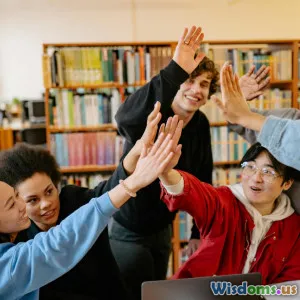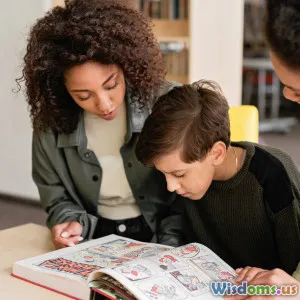
Is Collaboration the Key to Success in Education?
7 min read Exploring how collaboration fosters success in education through engagement, peer support, and innovation. (0 Reviews)
Is Collaboration the Key to Success in Education?
In an increasingly interconnected world, the capacity to work collaboratively emerges as a crucial skill, not only for success in professional environments but also in educational settings. Collaboration in education encompasses a range of practices, from cooperative learning activities to collaborative projects that engage students and enhance their learning experiences. The question arises: is collaboration the key to unlocking educational success? This article explores the significance of collaboration in modern education, backed by insights, data, and real-world examples.
The Importance of Collaboration in Learning
Enhancing Engagement and Motivation
Research indicates that collaborative learning environments significantly improve student engagement and motivation. When students work together, they feel a sense of accountability and are more likely to participate actively in their learning processes. In fact, a study from the Harvard Graduate School of Education highlights that collaborative learning often leads to increased motivation among students. For example, group projects or peer-led discussions allow learners to take ownership of their education while fostering a sense of community.
Building Essential Skills
Collaboration in education hones interpersonal skills such as communication, empathy, and leadership, which are vital for students in today's workforce. Skills such as problem-solving and critical thinking are reinforced in collaborative settings where students encounter diverse perspectives. According to the World Economic Forum, by 2025, 85 million jobs may be displaced by a shift in labor between humans and machines. Therefore, cultivating these soft skills through collaboration prepares students not only for academic success but also for the future job landscape.
Collaborative Learning Models
Several models of collaborative learning demonstrate the effectiveness of peer interaction. For instance, the Jigsaw Classroom strategy divides materials among small groups, ensuring each student becomes a subject matter expert on their assigned segment before teaching their peers. Research shows that students in jigsaw classrooms exhibit greater understanding and retention of knowledge while developing a respect for peer contributions.
Moreover, platforms like Google Classroom have facilitated collaborative projects among students, providing real-time feedback and promoting teamwork in a digital-first environment. This integration of technology in collaborative learning fosters an engaging setting essential for modern learners.
Case Studies: Success through Collaboration
Collaborative Learning in Early Education
Consider the Edgemere Elementary School in Tulsa, Oklahoma, which adopted a collaboration-focused curriculum. Students learn in small cohorts, often working together on projects that integrate subjects like science and mathematics. Not only did test scores improve, but the school reported a significant increase in student attendance and a decrease in behavioral issues, showcasing how teamwork can transform educational experiences.
Higher Education Innovations
Further up the educational ladder, universities have also prioritized collaboration. At Harvard University, the use of project-based learning is facilitated across departments, encouraging multidisciplinary teamwork that mirrors real-world challenges. Students collaborate with organizations on projects, gaining valuable insights while providing community service. This experiential learning model helps bridge the gap between curriculum and applicable skills in the job market.
The Role of Technology in Collaboration
Online Learning Environments
With the rise of online education, technology plays a pivotal role in enhancing collaboration. Virtual classrooms and platforms like Microsoft Teams and Zoom have redefined how students interact with one another. These platforms not only facilitate group discussions but also allow for resource sharing and brainstorming, replicating the collaborative dynamism of a physical classroom.
Global Collaboration
Furthermore, technology fosters global collaboration. For instance, Global Penfriends pairs classrooms from different countries, facilitating exchange projects that promote cultural understanding and global awareness. Such initiatives enhance students' social skills and adaptability while preparing them for a multicultural workforce.
Overcoming Challenges to Collaboration
While the benefits of collaboration in education are substantial, challenges exist. Educators must navigate varying levels of student participation and differing communication styles. Additionally, time constraints and classroom management can hinder effective collaboration. To overcome these challenges, teachers can implement structured methodologies, such as clearly defined roles for each group member and specific objectives to achieve during collaborative tasks.
Training educators in collaborative teaching techniques can further enhance success. Programs tailored to develop educators’ competencies in facilitating collaborative classrooms can result in a more cohesive educational experience for students
Conclusion: The Path Forward for Collaborative Education
Collaboration undeniably plays a central role in the success of modern education. As we continue to witness the complexities of global challenges, the importance of equipping students with the necessary skills to work together becomes even more pronounced. Educational institutions must embrace collaborative practices not just as methods for learning, but as foundational components of a holistic educational experience. By fostering teamwork, leveraging technology, and preparing students effectively, we can ensure that collaboration remains a key ingredient for success in education—transforming students into well-rounded individuals ready to tackle the challenges of tomorrow.
Indeed, the future of education is collaborative. As we move forward, we must prioritize partnership, communication, and shared learning experiences to embrace the educational landscape ahead.
Rate the Post
User Reviews
Popular Posts





















